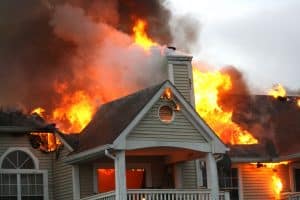Preventing House Fires and Burn Injuries
 Every year, thousands of people lose their homes and their lives from residential and house fires. Burning buildings can cause smoke inhalation, the release of toxic fumes, and severe burn injuries. Whether you experience a total or partial house fire, the experience can be absolutely terrifying and take a long time from which to emotionally and physically recover. Fire and smoke-related injuries can be serious and life-changing.
Every year, thousands of people lose their homes and their lives from residential and house fires. Burning buildings can cause smoke inhalation, the release of toxic fumes, and severe burn injuries. Whether you experience a total or partial house fire, the experience can be absolutely terrifying and take a long time from which to emotionally and physically recover. Fire and smoke-related injuries can be serious and life-changing.
United States fire statistics
The U.S. Fire Administration (USFA) collects data from a variety of sources each year to put together an analysis of the fire problem in the United States. They use this analysis in their work to increase fire safety awareness and set priorities. The most current report available, with data from 2019, shows the following statistics:
- 1,291,500 fires
- 3,704 related deaths
- 16,600 related burn injuries
- $14.8 billion in losses
These losses include the various wildfires across Colorado, California, and Tennessee.
Out of the 1,291,500 fires, 354,400 were residential fires.
What causes house fires?
Residential fires, or house fires, can ignite for a variety of reasons, but the National Fire Protection Association (NFPA) reports the number one cause is unattended cooking. The USFA’s report backs this up, with their top four leading causes of residential fires in 2019 as:
- 178,100 cooking fires
- 33,100 heating fires
- 27,200 other unintentional, careless fires
- 24,200 electrical malfunction fires
Preventing cooking fires
The majority of cooking fires occur from grease overheating and splattering. Grease is highly flammable and in the right conditions can burst into flame or catch something nearby on fire. Once a grease fire starts, it’s difficult to put it out and it can quickly grow out of control. Many house fires start because a person left their cooking unattended, and by the time they got back, the fire had already consumed the kitchen. Put out a grease fire by smothering the flames and depriving it of oxygen – NEVER put water on a grease fire. If you have any doubt about fighting a small fire, the NFPA advises to just get out immediately and call 911.
Preventing heating fires
Portable and space heaters help keep us warm, but are also the second leading cause of house fires. If used improperly or defective, space heaters can cause fires. If flammable items are left too close to a space heater, they can ignite. Some older portable heaters, especially those that run on kerosene, may tip over and start a fire if they don’t have the proper safety mechanisms. Always follow the instructions on space heaters and never leave them unattended or too close to flammable objects.
Preventing electrical fires
Faulty wiring and other electrical issues were responsible for over 20,000 house fires in 2019. These types of fires are often deadly, as they tend to ignite hidden and hard-to-access locations within a building. Electrical fires can build to nearly full strength before residents may even awaken from sleep. Especially if you live in an older home, it is always advisable to have your wiring inspected and repaired by a professional electrician to ensure everything is up to code. The NFPA offers a list of electrical safety tips.
Burn injuries from house fires
Burn and smoke injuries from a residential fire can leave a victim in pain for months, years, or permanently. These life-changing injuries are referred to as catastrophic, as they forever change the quality of a person’s life, affecting their ability to perform everyday tasks and partake in daily activities.
Burn injuries fall into four categories, or degrees, of severity, with first being the least severe and fourth being the most.
- First-degree. You can compare a first-degree burn to a sunburn. It causes minor pain and redness on the top layer of skin, the epidermis. These burns typically heal on their own after a few days.
- Second-degree. With this type of burn, the damage goes to lower layers of skin. Blisters may form and the skin is painful to the touch. The patient has a risk of infection and should seek medical care.
- Third-degree. These burns are very serious. The skin may appear dry, leathery, or even charred. The victim may not feel pain due to nerve damage. Surgery and skin grafts may be necessary, and risk of infection is high.
- Fourth-degree. Fourth-degree burns are usually fatal. These injuries go down to the bone, damaging all muscle and nerves. To survive, a victim may require amputation or extensive surgeries.
Smoke inhalation injuries are just as, if not more, dangerous as burn injuries. Respiratory dangers from house fires include:
- Lack of oxygen. A burning fire sucks the oxygen from the air, leaving too little behind for a human being to survive. Loss of oxygen causes a person to become drowsy, confused, and eventually unconscious.
- Inhaled gases. When a house is burning, so is everything inside it. This means inhaling combustibles and toxic gases from plastics, corrosives, and any number of things that can scar the lungs and nasal passages.
- Smoke. Smoke consists of a variety of particles and compounds that can irritate and damage the respiratory system permanently.
At Larson Law, our burn injury attorneys can help when you are injured in a fire that started from someone else’s negligence. We seek compensation on your behalf and protect your rights throughout the process. To arrange a free consultation, call us in Minot, Fargo or Bismarck today at 701.484.HURT or complete our contact form.

Mark Larson is a Certified Civil Trial Specialist and Certified Civil Pre-Trial Specialist focusing on personal injury, car accidents, wrongful death, and oil field claims. Since 1979, Larson Law has served the injured throughout North Dakota. Read more about Mark V. Larson.
